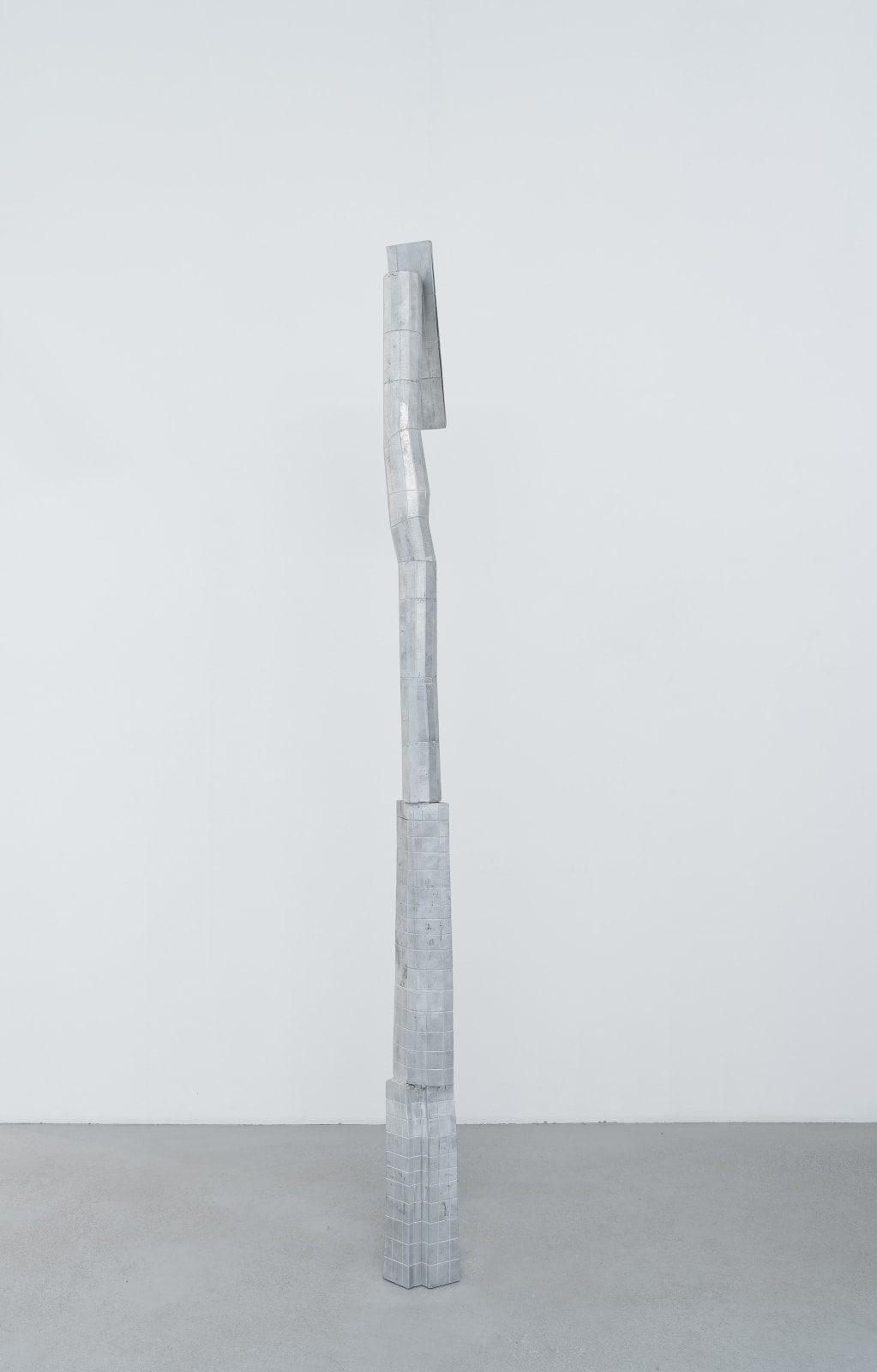Lou Jaworski
ZET, 2025
Cast aluminum
234 x 30 x 15 cm
92 1/8 x 11 3/4 x 5 7/8 inches
92 1/8 x 11 3/4 x 5 7/8 inches
Copyright The Artist
Photo: Dirk Tacke
Weitere Abbildungen
In „ZET“ (2025) bilden Aluminiumgüsse in Form von Holzscheiten eine nach oben strebende Skulptur, die die Silhouette eines Pfeils andeutet. Die Skulptur setzt das Holz als Träger von Zeit und...
In „ZET“ (2025) bilden Aluminiumgüsse in Form von Holzscheiten eine nach oben strebende Skulptur, die die Silhouette eines Pfeils andeutet. Die Skulptur setzt das Holz als Träger von Zeit und Geschichte in Beziehung zum Aluminium, das Form und Struktur bewahrt. Durch die geometrische Netzstruktur der Oberfläche, inspiriert von digitalen 3D-Renderings, verweist Jaworski auf die unendlichen Möglichkeiten der Modellierung und Erweiterung, die einerseits durch das organische Wachstum und andererseits durch computergenerierte Simulationen möglich ist. Dabei bezieht er sich auf das Konzept der Hyle: ursprünglich aus der griechischen Philosophie stammend, bezeichnet es eine Grundmaterie, die Ausgangspunkt für alles Formbare ist. Der Pfeil deutet dabei nicht nur Bewegung und Fortschritt an, sondern auch ein offenes Potenzial: Die Form bleibt in Bewegung, bereit für Veränderung und Weiterentwicklung. „ZET“ steht so sinnbildlich für Transformation, die in jedem Element eingeschrieben ist – von der organischen Natur zur präzisen Abstraktion. Die Skulptur bleibt Momentaufnahme eines Prozesses, der Form und Material stets neu definiert und zeigt, wie sich Materie von der Natur zur Abstraktion und von der Vergangenheit in die Zukunft bewegt.
In “ZET” (2025), aluminum castings in the shape of logs form an upward-striving sculpture that suggests the silhouette of an arrow. The sculpture relates the wood as a carrier of time and history to the aluminum, which preserves form and structure. Through the geometric mesh structure of the surface, inspired by digital 3D renderings, Jaworski refers to the infinite possibilities of modeling and expansion made possible by organic growth on the one hand and computer-generated simulations on the other. In doing so, he refers to the concept of the hyle: originally from Greek philosophy, it describes a basic material that is the starting point for everything that can be shaped. The arrow not only indicates movement and progress, but also an open potential: the form remains in motion, ready for change and further development. “ZET” thus symbolizes transformation, which is inscribed in every element - from organic nature to precise abstraction. The sculpture remains a snapshot of a process that constantly redefines form and material and shows how matter moves from nature to abstraction and from the past to the future.
In “ZET” (2025), aluminum castings in the shape of logs form an upward-striving sculpture that suggests the silhouette of an arrow. The sculpture relates the wood as a carrier of time and history to the aluminum, which preserves form and structure. Through the geometric mesh structure of the surface, inspired by digital 3D renderings, Jaworski refers to the infinite possibilities of modeling and expansion made possible by organic growth on the one hand and computer-generated simulations on the other. In doing so, he refers to the concept of the hyle: originally from Greek philosophy, it describes a basic material that is the starting point for everything that can be shaped. The arrow not only indicates movement and progress, but also an open potential: the form remains in motion, ready for change and further development. “ZET” thus symbolizes transformation, which is inscribed in every element - from organic nature to precise abstraction. The sculpture remains a snapshot of a process that constantly redefines form and material and shows how matter moves from nature to abstraction and from the past to the future.













